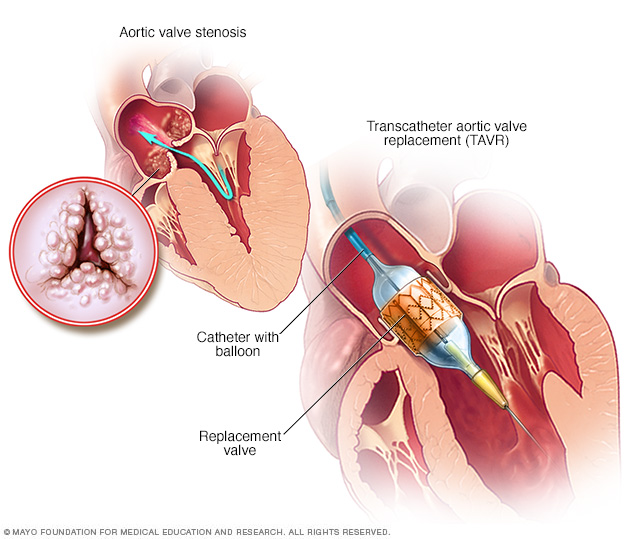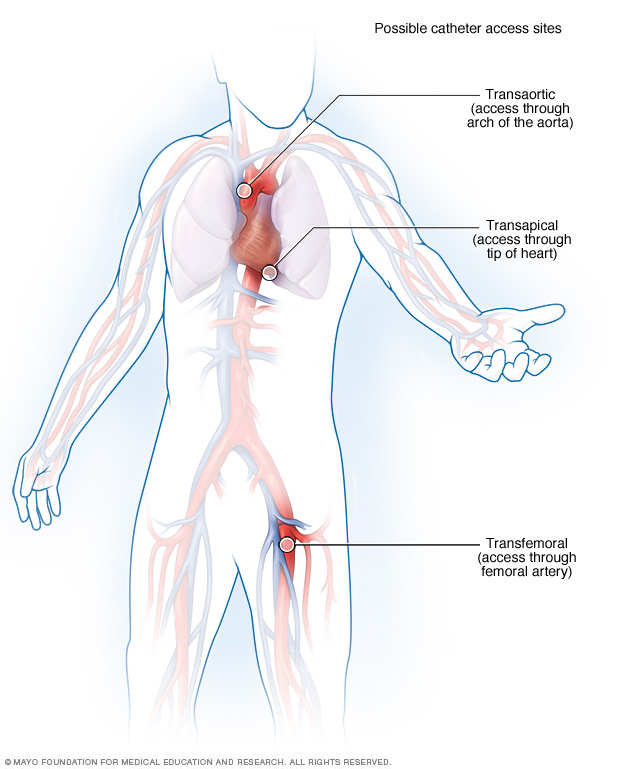Transcatheter aortic valve replacement (TAVR)
Overview
Transcatheter aortic valve replacement (TAVR) is a procedure to replace an aortic valve that is narrowed and doesn't open fully. The aortic valve is between the left lower heart chamber and the body's main artery. Narrowing of the aortic valve is called aortic valve stenosis. The valve problem blocks or slows blood flow from the heart to the body.
TAVR is minimally invasive, which means it uses smaller incisions than open-heart valve surgery. It may be an option for people who can't have heart surgery to replace the aortic valve. TAVR can help reduce chest pain, shortness of breath and other symptoms of aortic valve stenosis.
The decision to have TAVR is made after talking with a team of heart doctors and heart surgeons. The team works together to determine the best treatment option for you.
Transcatheter aortic valve replacement also may be called transcatheter aortic valve implantation (TAVI).

Transcatheter aortic valve replacement (TAVR) is a type of heart valve surgery. It's done to replace a narrowed aortic valve, a condition called aortic valve stenosis. A doctor inserts a flexible tube called a catheter into a blood vessel and guides it into the heart. A replacement valve made of cow or pig tissue goes through the tube to the specific area in the heart. A balloon on the catheter tip inflates to press the new valve into place. Some valves are self-expanding.
Why it's done
Transcatheter aortic valve replacement (TAVR) is a treatment for aortic valve stenosis. In this condition, also called aortic stenosis, the heart's aortic valve thickens and becomes stiff and narrow. As a result, the valve can't fully open and blood flow to the body is reduced.
TAVR is an alternative to open-heart aortic valve replacement surgery. People who have TAVR often have a shorter hospital stay than those who have heart surgery to replace the aortic valve.
Your doctor may recommend TAVR if you have:
- Severe aortic stenosis that causes symptoms such as chest pain and shortness of breath.
- A biological tissue aortic valve that isn't working as well as it should.
- Another health condition, such as lung or kidney disease, which makes open-heart valve replacement surgery too risky.
Risks
All surgeries and medical procedures come with some type of risk. Possible risks of transcatheter aortic valve replacement (TAVR) may include:
- Bleeding.
- Blood vessel problems.
- Problems with the replacement valve, such as the valve slipping out of place or leaking.
- Stroke.
- Heart rhythm problems and the need for a pacemaker.
- Kidney disease.
- Heart attack.
- Infection.
- Death.
Studies have found that the risks of disabling stroke and death are similar among those who have TAVR and aortic valve replacement surgery.
How you prepare
Your health care team gives you instructions on how to prepare for transcatheter aortic valve replacement (TAVR). Talk to your doctor if you have any questions about the procedure.
Food and medications
Tell your health care team about all the medicines you take and if you have any drug allergies. Include medicines and supplements bought without a prescription.
Before having TAVR, ask your health care team if and when you can take your regular medicines.
You usually are told not to drink or eat for a period of time before TAVR. Ask your health care team when you should do this.
Clothing and personal items
You may be asked to bring the following items to the hospital:
- Eyeglasses, hearing aids or dentures.
- Personal care items, such as a brush or comb, toothbrush, and shaving equipment.
- Loose-fitting, comfortable clothing.
- Items that may help you relax, such as portable music players or books.
During your procedure, do not wear:
- Contact lenses.
- Dentures.
- Eyeglasses.
- Jewelry.
- Nail polish.
What you can expect
Before the procedure
A health care professional places an IV into your forearm or hand. Medicine called a sedative goes through the IV. The medicine helps you feel relaxed, calm or sleepy. Medicines to prevent blood clots and infection also may be given through the IV.
A member of your health care team may shave any hair from the area on your body where the procedure will take place.
During the procedure
During transcatheter aortic valve replacement (TAVR), a doctor replaces a damaged aortic valve with one made from cow or pig heart tissue. The cow or pig valve is called a biological tissue valve. Sometimes, doctors place a biological tissue valve into an existing one that no longer works.
TAVR uses small surgery cuts and a flexible, hollow tube called a catheter to reach the heart. It's different from open-heart surgery to replace the aortic valve. That surgery requires a long cut down the chest.
To do TAVR, a doctor inserts a catheter into a blood vessel, usually in the groin or chest area. The doctor guides the catheter to the location of the aortic valve in the heart using X-ray or other imaging tools as a guide.
The doctor sends a biologic tissue valve through the catheter and places it in the area of the aortic valve. A balloon on the catheter tip expands to press the new aortic valve into place. Some replacement valves expand without the use of a balloon.
The doctor removes the catheter once the new valve is securely in place.
During TAVR, your health care team carefully watches you. Your blood pressure, heart rate and rhythm, and breathing are constantly checked.
After the procedure
You may spend the night in a hospital's intensive care unit (ICU) so you can be carefully watched after your procedure. How long you stay in the hospital after TAVR depends on many things. Some people who have TAVR might go home the next day.
Before you leave the hospital, your treatment team tells you how to care for any wounds and how to watch for symptoms of infection. Warning signs of infection include fever, increased pain and redness, swelling, draining or oozing at the catheter site.
Several medicines may be prescribed after TAVR, including:
- Blood thinners, also called anticoagulants. This medicine helps prevent blood clots. Your health care team tells you how long you may need to take this medicine. Always take medicines as directed.
- Antibiotics. These medicines treat and prevent bacterial infections. Germs can stick to or infect an artificial heart valve. Most bacteria that cause heart valve infections come from the bacteria in the mouth. Taking good care of your teeth and mouth can help prevent these infections. Get regular dental checkups. Antibiotics may be prescribed for use before certain dental procedures.
Regular doctor's checkups and imaging tests are needed after TAVR to make sure the new valve is working properly. Let your doctor know if you have any new or worsening symptoms, including:
- Dizziness or light-headedness.
- Swelling of the ankles.
- Sudden weight gain.
- Extreme tiredness with activity.
- Swelling, redness, tenderness or other signs of infection at the catheter site.
Seek emergency medical help if you have:
- Chest pain, pressure or tightness.
- Severe, sudden shortness of breath.
- Fainting.

Transcatheter aortic valve replacement (TAVR) is done using a flexible, hollow tube called a catheter. The doctor inserts the catheter into a blood vessel, usually in the groin or chest area. Sometimes, other methods are used to reach the heart.
Results
Transcatheter aortic valve replacement (TAVR) may reduce symptoms of aortic valve stenosis. Fewer symptoms may help improve quality of life.
Following a heart-healthy lifestyle is important as you recover from TAVR. Such lifestyle habits also can help prevent other heart problems. After TAVR:
- Don't smoke.
- Eat a heathy diet rich in fruits and veggies and low in salt and saturated and trans fats.
- Get regular exercise — talk to your doctor before starting a new exercise routine.
- Maintain a healthy weight. Ask your health care team what a healthy weight is for you.
Last Updated Sep 6, 2023
© 2024 Mayo Foundation for Medical Education and Research (MFMER). All rights reserved. Terms of Use